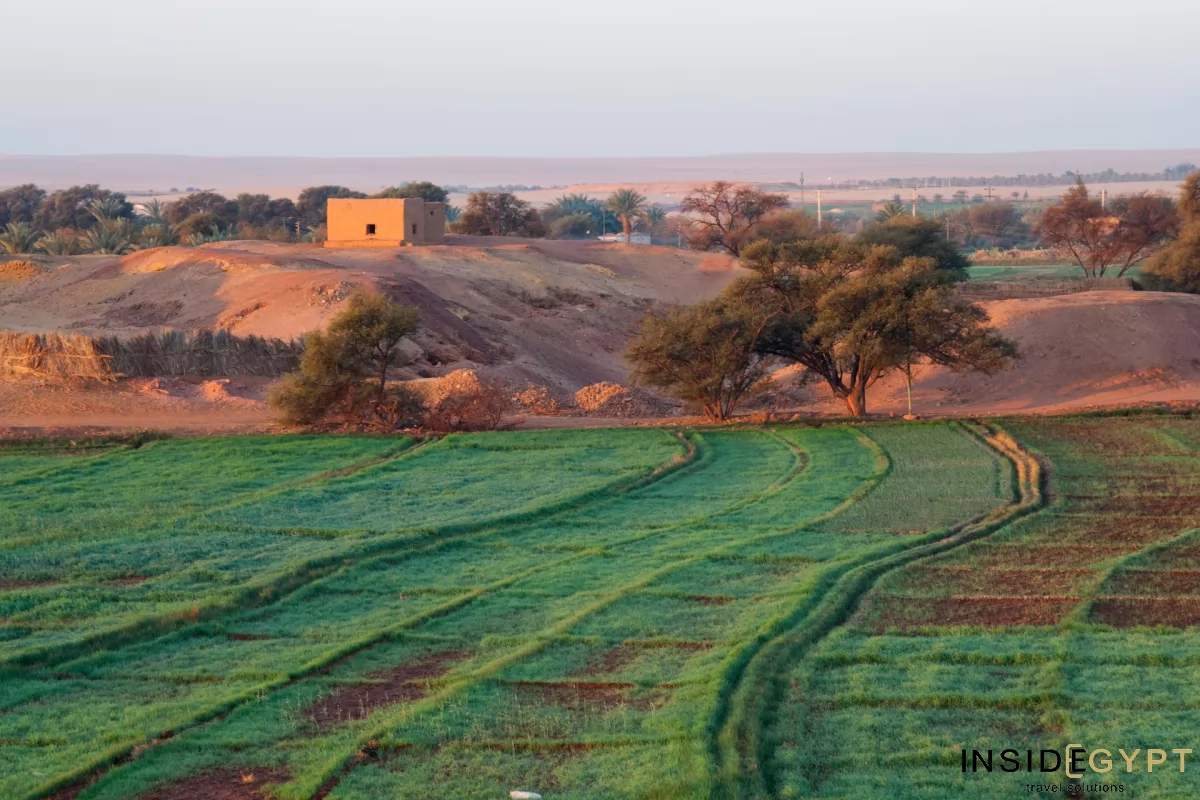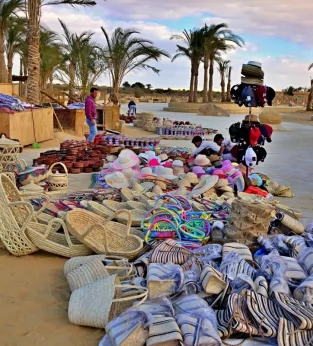Stay updated!
Dakhla oasis can be described by just one word "diversity". This applies to both the monuments - Roman and Egyptian - and the inhabitants who live in it: Nubians, Libyans, Berbers and Bedouins.
Dakhla is sometimes called El Wah, the Inner Settlement because of its location between the oases of Farafra and Baharyia in the north and Kharga in the south. As recently as 10,000 years ago, most of the area of today's Dakhla oasis (2,000 km2) was under the surface of a shallow lake surrounded by tall grasses and trees, reminiscent of today's African savannah.
Neolithic frescoes on the rocky slopes of the hills around the city of Tineida depicting wild animals, indicating that elephants, zebras, giraffes, antelopes and ostriches lived here. Then came a period of drought, which meant that both the animals and the people inhabiting the area left in search of water sources. Today, thanks to the possibility of applying new technological solutions in agriculture, thousands of people have returned to Dakhla's oasis. The oasis is the most densely populated in the Western Desert (40 people / km2). The main occupation of the local population is the cultivation and export of fruit. They also cultivate local craft traditions: weaving baskets and making pottery, jewelry and wooden items.
Deir El Hagar
Deir El Hagar means Stone Monastery in Arabic, because the temple was built entirely of sandstone. It is situated at the western end of the Dakhla oasis. The temple's construction was started by the Emperor Nero, and the following rulers erected new buildings and introduced new elements of decoration to the temple. The entire complex is surrounded by a wall, and in its eastern part you will find the main gate. You will find traces of painted plaster, with Greek inscriptions and signatures left here by ancient travelers and these have been preserved in the wall.
The columns that flank the processional avenue leading to the entrance to the temple are an architectural surprise. They were made of mud brick, not stone as is normally used. Some of them are decorated with inscriptions and geometric ornaments. When the temple was covered, the columns were part of the pillared hall that preceded the entrance to the sanctuary. In antiquity, statues of sphinxes stood between the columns (now in the New Valley Museum in Kharga).
The sanctuary was a real gallery of paintings. The entire ceiling was covered with astronomical frescoes (this part of the decorations was moved to the front of the temple, where they can be viewed). The centerpiece of the decoration is the image of the goddess of Heaven, Nut. Her body is arched - like the sky. Beneath it lies the god of the earth, Geb. The space between them is filled with stars and constellations, including the constellation Orion, symbolized by the god Osiris. The walls of the sanctuary are covered with frescoes and bas-reliefs that depict various deities.
Qasr
The tangle of narrow, dust-covered streets and small squares. The buildings in Qasr still evoke the atmosphere of the 12th century when the city was founded. Qasr is the best-preserved fortified Islamic settlement in the oasis of Dakhla. While walking around the city, it is worth taking a closer look at the local mud-brick houses - the jambs and lintels of many of them are decorated with geometric and floral ornaments. Richly carved, heavy trees are not uncommon.
The 21-meter-high minaret of the Nasr El Din mosque towers over the city, picturesquely situated at the foot of a limestone escarpment. It is the only original element of this 12th-13th century temple, which was completely destroyed over time. The mosque was rebuilt at the end of the 19th century and the wooden entrance lintel is decorated with a Koranic inscription. Adjacent to the mosque is a madrasah - a Koranic school where young boys study. Today, the renovated building is still the seat of a secular school. It is also a place of public meetings of residents.
Only about 1,000 people live in Qasr today. Many of them continue medieval craftsmanship. They made Qasr famous with their hand-made clay pots and baskets woven from palm leaves.
Ismant El Kharab
2 km east of what is now the village of Ismant, the densely populated and bustling trading city of Kellis was ancient antiquity. It was inhabited from the Ptolemaic Period (4th-1st century BC to around the 4th century AD). Of the numerous houses, warehouses, baths, aqueducts and churches, only the ruins called Ismant El Kharab - "Ruined Ismant" remain.
An interesting monument preserved in Ismant El Kharab is the temple of the mysterious god Tutu - it is the only known place of his worship in Egypt. This god bore the title of the Lord of Demons, as he provided help and protection against evil powers and against the goddess Sekhmet, who, according to Egyptian beliefs, sent plagues on humanity. The god Tutu was depicted as a lion or a sphinx with a human head, sometimes he also had bird wings and a snake's tail. His images can be seen on the walls of one of the chapels. Archaeologists also reconstructed the painted ceiling.
The site of Kellis is also home to the most ancient church in Egypt, belonging to the Manichaean community. It was built in the 4th century of mud brick. Soon the community built two more churches from the same material. Due to its impermanence, only the foundations and walls of the temples have survived, sometimes reaching 4 meters in height, and in some places covered with remnants of white plaster.
In one of the churches, three wooden "books" called the Kellis Codes were discovered. One of the documents consists of nine wooden tablets with speeches and political declarations, the other contains eight tablets, they are written bills. The third document is the contract of sale of the house. These are one of the few objects of this type that have survived to today - mainly due to the perishable material from which they were made. All three codices can be viewed at the New Valley Museum in Kharga.
A surprising find at Kellis were composite mummies (present at the New Valley Museum in Kharga). They were made by joining body parts from different corpses. They were folded on a wooden panel and then wrapped with bandages to resemble a real mummy. The reason why the body was buried in such an unusual form remains a mystery.
Let the adventure of a lifetime begin. Book your luxury Egypt tour today!






